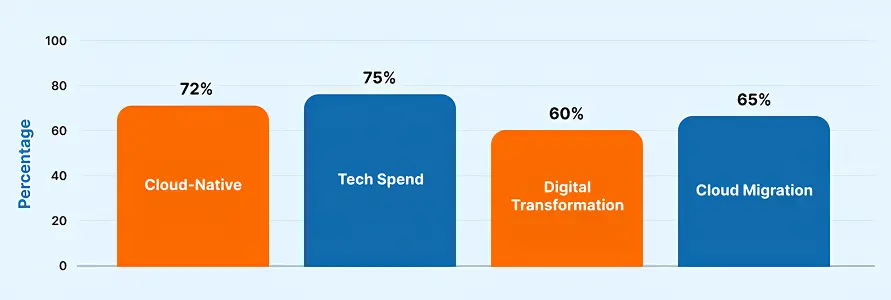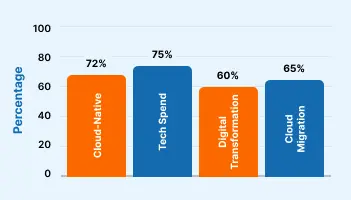
How to Future-Proof Your Tech Stack for 2025 and Beyond
Introduction
Technology changes quickly, and businesses that don’t keep up often struggle to stay competitive. New tools, languages, and frameworks appear every year. What worked well a few years ago may already be outdated today.
Future-proofing your tech stack means building a strong, flexible foundation that can grow and adapt as your business and the technology evolves.
In this article, we’ll explore practical ways to keep your tech stack modern and flexible using modular designs, cloud-native platforms, and scalable frameworks.
Why Future-Proofing Your Tech Stack Matters
A tech stack isn’t just a set of tools. It affects how fast you can launch products, how easy it is to scale, and how smooth your customer experience is.
Many businesses face problems when their systems can’t handle new technologies or growing demand. Legacy tools often slow down development and make it harder to innovate.
Hence, at present, most of the companies are working on digital change. Here are some key stats that show why many companies are investing in modernizing their tech:


In the TEKsystems 2025 survey, 72% of organizations say cloud-native platforms are already in use. Same report says about 75% of digital leaders plan to increase spending on tech initiatives this year.
In another report, 60% of companies worldwide have picked digital transformation as a top priority.
Also, 65% of organizations say cloud migration is helping them with their digital transformation moves.
These numbers show that many firms know they must update tech stacks if they want to stay competitive.
Here are simple reasons upgrading matters now:
- New features can be released faster when parts are built in modern ways
- Scaling up (more users, more traffic) becomes less painful
- Easier to hire developers when stack uses popular, modern tools
- Avoid big rewrites later, which cost more time and money
- Better chance to meet changing rules, customer demands, and market changes
Adapt Modular Architectures
Modular architecture is a smarter way to build software. Instead of creating one large system where everything is tightly connected, the application is divided into smaller, independent parts called modules. Each module focuses on a specific task and works with the others through simple, clear connections.
This approach gives businesses more control and flexibility. Teams can build, test, and launch different modules separately without waiting for the entire system to be ready. If one part needs changes, it can be updated without interrupting the rest of the system.

 Key benefits of modular architecture:
Key benefits of modular architecture:
- Faster development: Different teams can work on separate modules at the same time, which speeds up overall progress.
- Easier updates and maintenance: Modules can be improved one by one without affecting the whole system.
- More flexibility: New tools or features can be added gradually, without rebuilding everything from scratch.
- Lower risk of failure: If one module has a problem, the rest of the system can keep running normally.
 Example:
Example:
Imagine a retail company with separate modules for payments, inventory, and product recommendations. If the company decides to support a new payment option, like a digital wallet or a buy-now-pay-later service, only the payment module needs to be updated. The inventory and recommendation modules keep working as they are.
This structure also makes scaling easier. If the payment system receives more traffic during a big sale, only that module can be scaled up without affecting others.
Moving Towards Cloud-Native Solutions
Cloud-native technologies let businesses build and run applications in a way that fully uses the advantages of the cloud. Instead of relying on physical servers, companies use cloud platforms such as AWS, Azure, or Google Cloud to host their applications.
This approach gives businesses the flexibility to respond quickly to changing needs, handle growing traffic, and release new features without long delays. Cloud-native solutions also make it easier to manage infrastructure because much of the scaling and maintenance is handled by the cloud provider.

 Key benefits of cloud-native solutions:
Key benefits of cloud-native solutions:
- Easier scaling: Applications can automatically handle more users or higher workloads without manual intervention.
- Lower upfront costs: Businesses avoid buying expensive servers and only pay for the resources they use.
- Faster deployment and updates: Teams can release new features, bug fixes, or updates more quickly.
- Better reliability: Distributed systems and cloud redundancy reduce downtime and prevent single points of failure.
 Practical Example:
Practical Example:
A streaming service can use cloud-native tools to handle sudden spikes in traffic during popular events. When a show goes viral, the platform automatically allocates more resources to handle the demand. Developers can also push new features, like personalized recommendations or live chat, without taking the service offline.
Cloud-native solutions make it easier for businesses to experiment, adapt, and scale their applications without being held back by hardware limitations or manual processes.
Building with Scalable Frameworks
Scalability is a key part of future-proofing. A scalable framework allows your system to handle increased users and data as your business grows, without requiring a complete rebuild.

Prioritize Security and Compliance
Future-proofing isn’t just about speed and flexibility. Security plays a huge role. As systems grow and become more complex, weak points can appear if security isn’t built in from the start.

 Here are a few simple steps to keep security strong:
Here are a few simple steps to keep security strong:
- Use Identity and Access Controls: Limit who can access different parts of your system to prevent unauthorized actions.
- Keep Software Updated: Regular updates fix known vulnerabilities and protect against new threats.
- Follow Data Protection Regulations: Follow rules like GDPR or HIPAA to protect sensitive data and stay compliant.
- Run Regular Security Audits and Penetration Tests: Check systems often to find and fix potential security issues.
 Why It Matters
Why It Matters
According to IBM’s Cost of a Data Breach Report 2025, the global average cost of a data breach has reached 4.4 million USD. This shows how costly security failures can be for businesses.
 Real-World Impact
Real-World Impact
- Financial Loss: Breaches can lead to direct costs, lost business, and fines.
- Service Disruption: Attacks often cause downtime, affecting customers and operations.
- Legal Issues: Not following data rules can result in penalties or lawsuits.
Hence, it’s important to build strong security from the beginning. It protects your data, reputation, and business future. Proactive security helps reduce risks and supports longterm growth.
Use Automation and AI Tools
Automation helps reduce repetitive tasks so teams can focus on strategy and innovation. AI tools can help detect bugs, predict system failures, or suggest code improvements.

 How Automation and AI Are Used
How Automation and AI Are Used
- Automated Testing and Deployment: Automatically checks software for errors and releases updates faster.
- Monitoring Systems: Watches servers, networks, and applications and alerts teams before problems happen.
- AI Code Helpers: Tools like GitHub Copilot suggest code improvements and help developers work faster.
- Run Regular Security Audits and Penetration Tests: Check systems often to find and fix potential security issues.
 Impact on Business
Impact on Business
According to PwC, AI could add $15.7 trillion to the global economy by 2030. Companies using AI early often build software faster, make fewer mistakes, and make better decisions.
Hence, using automation and AI helps businesses save time, reduce errors, and deliver software faster. Adding these tools to your tech stack is important to keep systems ready for the future.
Common Mistakes to Avoid
Future-proofing a tech stack can bring many benefits, but some mistakes can cause problems. Here are common mistakes and ways to fix them:
| Common Mistake | Potential Solution |
|---|---|
| Choosing trendy but unstable tools | Check the tool’s track record, community support, and update frequency before adopting it. |
| Ignoring proper documentation and testing | Keep clear documentation and run thorough tests to make maintenance and updates easier. |
| Overcomplicating the architecture | Use simple, modular design and add features gradually when needed. |
| Skipping security planning | Build security from the start with access controls, updates, and regular audits. |
| Not training teams on new tools and frameworks | Provide training and resources so teams can use new tools effectively. |
Future Vision for Modern Tech Stacks
The future of tech stacks will focus on flexibility, speed, and smart automation. More businesses will rely on hybrid and multi-cloud setups, combining public and private cloud systems. Low-code and no-code tools will continue to grow, helping teams build apps faster without deep programming knowledge.
AI will also become a core part of how applications are built and maintained, making systems more adaptive and predictive.
Companies that keep their stacks modern will be able to react quickly to new trends, regulations, and customer needs, giving them a strong edge over slower competitors.
Conclusion
Technology keeps evolving, and businesses need systems that can adapt and grow. A smart, flexible tech stack is the key to staying competitive. By combining modular designs, cloud-native platforms, scalable frameworks, strong security practices, and automation with AI tools, companies can create a foundation that handles growth, change, and new opportunities with confidence.
A future-ready tech stack not only helps teams work faster and more efficiently, it also reduces risks, simplifies updates, and makes it easier to adopt new technologies as they emerge. Companies that invest in a strong, adaptable infrastructure are better prepared to meet customer expectations and market changes.
At Brevity Technology Solutions, we help businesses modernize their tech systems and build stacks that are prepared for the future. We work closely with our clients to understand their unique needs, select the right tools, and implement solutions that are scalable, secure, and maintainable.
If you want to take your tech stack to the next level, you can book a free consultation call with our team. We’ll review your current systems, identify opportunities for improvement, and guide you in creating a tech foundation that can grow with your business.
Related Post
-
F
-
A
-
Q
Future-proofing a tech stack means designing and building your systems so they can handle growth, changes, and new technologies without needing a complete rebuild.
Modular architecture breaks a system into smaller, independent parts. This makes updates, maintenance, and adding new features easier and safer.
Cloud-native technologies let businesses run applications on cloud platforms like AWS, Azure, or Google Cloud. They make scaling, updates, and resource management faster and simpler.
Scalable frameworks, like React, Node.js, Django, and Spring Boot, allow your system to handle more users and data as your business grows. They reduce the need for a full rebuild.
Without modernization, businesses may face increased downtime, higher maintenance costs, and challenges in meeting customer expectations.
Use identity and access controls, keep software updated, follow data protection rules (like GDPR or HIPAA), and run regular audits and penetration tests to protect your systems.
Automation reduces repetitive tasks, while AI can detect bugs, suggest code improvements, and predict system issues. Together, they save time, reduce errors, and speed up development.
Avoid picking unstable tools, skipping documentation or testing, overcomplicating architecture, ignoring security, and not training teams on new tools.
Yes. Even startups can use modular designs, cloud platforms, scalable frameworks, and automation tools to make systems flexible, secure, and ready to grow.
Start by identifying areas that can benefit from technology, like cloud hosting, automation, or modular updates. Choose tools that fit your budget and team skills. If you want guidance, you can book a free consultation call with our team. We can help plan and implement the right solution for your business.
Want to Scale
Your Business? Let’s Meet & Discuss!

CANADA
30 Eglinton Ave W Mississauga, Ontario L5R 3E7

INDIA
3rd floor Purusharth Plaza, Amin Marg, Rajkot, Gujarat. 360002
Get a Quote Now
Let's delve into a thorough understanding of your challenges and explore potential solutions together


